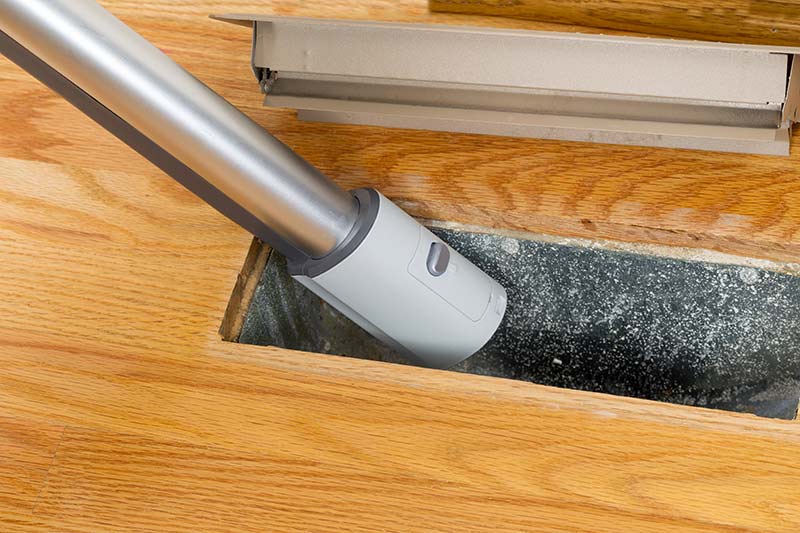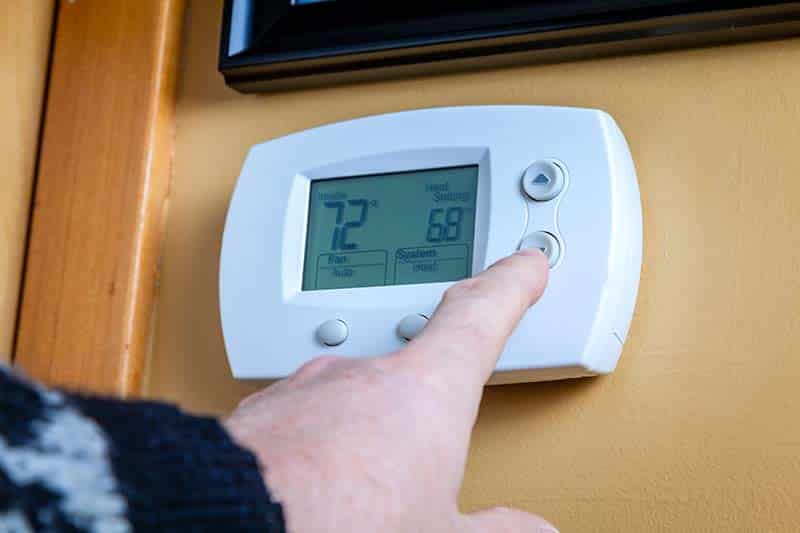We've independently reviewed this article to make sure it's as accurate as we can make it.
To find out more about our article creation and review process, check out our editorial guidelines.
A furnace has the potential to make or break the comfort of your home.
Even if you don’t live in a cold climate with freezing and snowy winters, a furnace can help you better manage your home’s moisture and temperature levels AND your subsequent health.
After all, a cold home is not only uncomfortable — it can be dangerous. Cold homes can make a person more susceptible to pneumonia, high blood pressure, and viruses.
With all that said, a properly functioning furnace is essential to any home. So, how often should you run a furnace and how long for? What are ways you can maintain and extend the lifetime of your furnace?
Let’s find out!
How Often & Long Should You Run a Furnace?
Generally speaking, a healthy furnace runs for 15 minutes per cycle, two to three times per hour. The amount of these cycles will vary and depend on the time of year and how high you have set your thermostat.
Of course, in the wintertime or when outside temperatures are freezing cold, you should expect to turn your thermostat up higher so your furnace runs more often to achieve and maintain a warm and comfortable temperature.
In the autumn and spring, when temperatures are more moderate, you likely won’t have the thermostat raised high enough to yield more than a few heating cycles per day.
However, if your furnace is not properly functioning, it can experience what’s known as short cycling.
What Is Short Cycling in a Furnace?
Short cycling occurs when a furnace turns on and off frequently with little time in between. A short cycling furnace can’t create enough heat to maintain a warm and comfortable climate in a home. A severely short cycling furnace might not be able to create any heat at all.
What are the signs of a short cycling furnace? Here are some of the tell-tale signs:
- Your vents produce short bursts of heat.
- The area surrounding your furnace is overheated.
- The readings on your thermostat are inaccurate.
What causes a furnace to short cycle? There can be a number of causes, but the most common is a bad flame sensor. A bad flame sensor is unable to detect heat from the furnace. As a result, it will continually shut the gas and furnace off soon after lighting, before the rest of your home can receive adequate warm airflow.
Dirty vents and filters can block the flow of returning air to your furnace, causing it to short cycle and shut down, as well. If your furnace’s heat vents produce hot air, this can also indicate dirty vents or filters. If you suspect your furnace is short cycling, check to make sure your heat vents are open and free of obstructions.
Is Furnace Short Cycling Dangerous?
A short cycling furnace can cause long-term, irreversible damage to your furnace if you don’t repair it immediately.
Because short cycles cause a furnace to overheat, the harder your furnace will have to work to provide adequate warm air to the rests of your home. This can cause premature wear and tear of the parts within the furnace. It can also cause damage to your furnace’s extremities, like the vents and thermostat, result in repairs, and increase the likelihood of having to replace the furnace altogether.
Short cycling can also be a sign of a much larger issue going on with your furnace, and if not addressed immediately, can pose danger to your health and safety.
How Can You Prevent a Short Cycling Furnace?
As soon as you suspect short cycling in your furnace, act promptly. Check your flame sensor for rust or corrosion, and monitor your thermostat for unusual or unexplainable fluctuations in temperature.
Make sure you regularly clean out your air filters and vents and minimize obstructions to your home’s airflow. If cleaning out your filters and vents and fixing the flame sensor yields little results and your furnace continues to short cycle, it may be time to replace it — especially if you have an older model.

Block Flue Pipe
HVAC Expert: In my experience, a blocked flue pipe can also cause overheating and short cycling. Birds can get into the flue pipe, especially if the cap is missing. The only thing I can recommend a homeowner could check would be to look on their roof, find the flue and see if it is missing the cap or screen which would prevent birds from entering the pipe.
Is It Bad for a Furnace to Run Frequently?
Understanding how often a healthy furnace should run and how long can help you better monitor and manage your monthly energy bill costs. But if you are someone who enjoys a toasty and cozy home during the cold months, is it bad to keep your thermostat up and have your furnace run frequently?
A furnace that’s kept at higher temperatures and for longer durations won’t cause immediate problems; however, frequently running your furnace or keeping it at higher temperatures can cause more wear and tear over time.
If you don’t mind paying higher energy bills in the wintertime to maintain a warm oasis in your home, then keeping your thermostat up and running the furnace more often shouldn’t be an issue. Keep in mind, however, gas furnaces use up more energy and emit more carbon dioxide into the atmosphere.
There are more energy-efficient furnaces and HVAC systems that emit less CO2 each year. If you’re not in the market to replace your current furnace, there are ways you can warm up your home, practice better energy efficiency, and maintain the lifetime of your furnace, which we’ll explore next!
How to Improve Your Furnace Performance & Energy Efficiency
If preserving the lifetime of your furnace and energy efficiency are your main concerns, the US Department of Energy recommends setting your thermostat at 68°F/20°C during the day.
You may be thinking: “68°F/20°C is way too cold where I live. How can I possibly stay warm when the snow and freezing temperatures roll around?” You may even be wondering how often a healthy furnace should run and how long for at the recommended 68°F/20°C.
Did you know? This temperature is also the level used by HVAC professionals to size your furnace and AC setups. It’s what your furnace is typically designed to maintain.

When you’re home, feel free to bump up your thermostat a few degrees 2-4 hours is a good rule of thumb. Setting your warmest heating cycles for only a few hours per day shouldn’t deal a huge blow to your monthly energy bills — just make sure to turn your thermostat back 10-15° when you’re not at home and at night time when you’re asleep to offset these higher cycles.
Here’s what they can look like, according to the US Department of Energy:

Improve Your Home’s Insulation
No homeowner should rely solely on their furnace to stay warm. Having adequate insulation in your home will not only maintain your warmth and comfort but will also help to maintain a healthy furnace.
There are several insulation materials to choose from, and without a doubt, spray foam insulation and traditional fiberglass insulation are the most common.
Which is better: Spray foam vs fiberglass insulation? We have an entire article dedicated to the debate and you can read it here.
In short, both spray foam and fiberglass insulation are effective insulating materials, but spray foam may be the better option if your home requires a complete overhaul in its insulation system, or if you own commercial space. If you’re simply looking to add to your home’s pre-existing insulation, fiberglass should suffice.
Adequate insulation in your attic (by far the most important), crawl spaces, and walls will keep colder air out and warmer air in, reducing the need to turn up the thermostat and have your furnace running more frequently.
Go the Extra Mile to Stay Warm & Keep Your Thermostat Down
In addition to upgrading the insulation in your home, there are other tricks and tips to warm up a home without turning the heat on.
First, check your attic, walls, and windows for air gaps, leaks, cracks, and holes. By sealing these up, you can prevent air and moisture leaks and preserve warmer air indoors.
In rooms where you spend more time in the winter, such as your bedroom or living room, consider using a space heater. Energy efficient space heaters like oil-filled radiators or infrared heaters use up less energy than furnaces (at least when only heating one room vs the whole home). They also won’t cause a significant spike in your monthly bills (so long as you aren’t keeping the space heater on all day, every day.)
You can also install thick curtains to cover your windows. These will help maintain the flow of warm air throughout a room and keep colder air out. Adding a thick and shaggy area rug can also add warmth to any room. And, of course, if you’re looking for cost-effective ways to stay warmer at home, you can always treat yourself to some reliable throw blankets, fuzzy socks, and cozy winter-friendly clothes!
Understanding How to Maintain a Healthy Furnace
A healthy and properly working furnace is one of many blessings in a home; but if not maintained, your furnace can quickly turn into a nightmare of expensive repairs and a ghastly cold home.
The key to maintaining a healthy furnace is to understand how often it should run and how long.
Contrary to popular belief, you don’t need to keep your furnace on constantly to maintain a warm home. By monitoring your furnace for short cycling, using your thermostat modestly, and incorporating other ways to insulate and keep your home warm, you can preserve and extend the lifetime of your furnace for years to come.
Looking for other ways to improve your home’s warmth, comfort, and energy efficiency? Stay tuned to our blog for more home improvement ideas!







